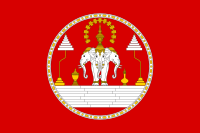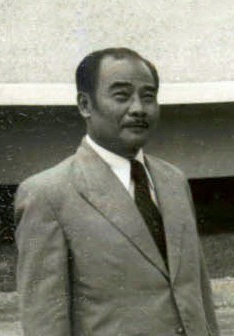
Prince Souphanouvong, nicknamed the Red Prince, was along with his half-brother Prince Souvanna Phouma and Prince Boun Oum of Champasak, one of the "Three Princes" who represented respectively the communist (pro-Vietnam), neutralist and royalist political factions in Laos. He was the President of Laos from December 1975 to August 1991.
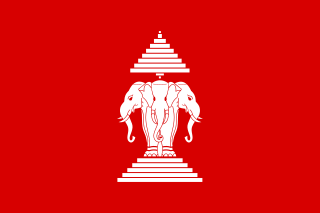
The Kingdom of Laos was a landlocked country in Southeast Asia at the heart of the Indochinese Peninsula. It was bordered by Burma and China to the northwest, North Vietnam to the east, Cambodia to the southeast, and Thailand to the west and southwest. The country was governed as a constitutional monarchy that ruled Laos beginning with its independence on 9 November 1953. It survived until December 1975, when its last king, Sisavang Vatthana, surrendered the throne to the Pathet Lao during the civil war in Laos, who abolished the monarchy in favour of a Marxist–Leninist state called the Lao People's Democratic Republic, which has controlled Laos ever since.

King Sisavangvong Born Prince Khao(ຂເ-ົາ), was one of the last kings of Luang Prabang ruling from 28th of April 1904 until his death on the 29th of October 1959. According to Lao customs, while being crowned khao would be given a Courtesy name Sisavangvong and be addressed by his courtesy name until his death.

Prince Souvanna Phouma was the leader of the neutralist faction and Prime Minister of the Kingdom of Laos several times.

Sisavang Vatthana or sometimes Savang Vatthana was the last king of the Kingdom of Laos and the 6th Prime Minister of Laos serving from 29 October to 21 November 1951. He ruled from 1959 after his father's death until his forced abdication in 1975. His rule ended with the takeover by the Pathet Lao in 1975, after which he and his family were sent to a re-education camp by the new government.
Major General Phoumi Nosavan was a military strongman who was prominent in the history of the Kingdom of Laos; at times, he dominated its political life to the point of being a virtual dictator. He was born in Savannakhet, the French Protectorate of Laos, on 27 January 1920. Originally a civil servant in the French colonial administration of Laos, during the last year of World War II he joined the resistance movement against the Japanese occupiers. Exiled from 1946 to early 1949 for his opposition to French return to colonizing Laos, he returned to his native soil to begin a military career in 1950 after the collapse of the anti-French Lao Issara government. By 1955, he was Chief of Staff of the brand-new Royal Lao Army. While in that position, he was largely responsible for appointing senior officers into command positions in the Military Regions of Laos. Following that, in 1957 he was the first Lao officer to be schooled in France at the École de Guerre. While in France, he became acquainted with Central Intelligence Agency operative John F. "Jack" Hasey. Phoumi returned to Laos to become a founding member of the Committee for the Defence of National Interests on 17 June 1958. On 25 December 1959, he took control of the capital of Vientiane and of the nation in a bloodless coup.
Prince Sauryavong Savang was the youngest son of King Savang Vatthana of Laos. In 1965, he married Princess Dalavan and they had four children, Sthira Sauryavong, Dayavant Sauryavong, Balavant Sauryavong, and Krishnajina Sauryavong.

The Three Princes was a name given to Princes Boun Oum, Souvanna Phouma and Souphanouvong who represented respectively the royalist, neutralist and communist factions in the Kingdom of Laos in the post-WWII period. The trio were named by King Sisavang Vatthana to form a coalition government following the independence of Laos.

Khamphoui was the Queen of Laos by marriage to Sisavang Vatthana, the second King of Laos. She was arrested with the rest of her family and reportedly died in a re-education camp in 1982.
Crown Prince Soulivong Savang, grandson of the last King of Laos Savang Vatthana, is the pretender to the Lao throne. Laos was a monarchy until 1975, when the communist Pathet Lao seized control of the nation, causing Savang Vatthana to abdicate his throne. Soulivong Savang lives in exile in Paris.

The Laotian Civil War (1959–1975) was a civil war in Laos which was waged between the Communist Pathet Lao and the Royal Lao Government from 23 May 1959 to 2 December 1975. It is associated with the Cambodian Civil War and the Vietnam War, with both sides receiving heavy external support in a proxy war between the global Cold War superpowers. It is called the Secret War among the American CIA Special Activities Center, and Hmong and Mien veterans of the conflict.
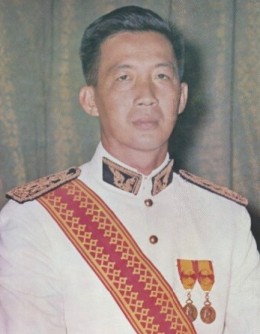
Vong Savang was the Crown Prince to throne of the Kingdom of Laos. After the Laotian Civil War in 1975, he and his family were arrested by the Pathet Lao and sent to re-education camps, where they died.

The Royal Palace in Luang Prabang, Laos, was built in 1904 during the French colonial era for King Sisavang Vong and his family. The site for the palace was chosen so that official visitors to Luang Prabang could disembark from their river voyages directly below the palace and be received there. After the death of King Sisavang Vong, the Crown Prince Savang Vatthana and his family were the last to occupy the grounds. In 1975, the monarchy was overthrown by the communists and the royal family were taken to re-education camps. The palace was then converted into a national museum.

The Prime Minister of the Lao People's Democratic Republic, formerly the chairman of the Council of Government of the Lao People's Democratic Republic, is the head of government of Laos. The highest position in the government, they direct the country's executive branch. The prime minister is accountable to the president, the National Assembly and the country's only legal party: the Lao People's Revolutionary Party (LPRP). The current prime minister is Phankham Viphavanh, who was elected in 2021.

The French protectorate of Laos was a French protectorate in Southeast Asia of what is today Laos between 1893 and 1953—with a brief interregnum as a Japanese puppet state in 1945—which constituted part of French Indochina. It was established over the Siamese vassal, the Kingdom of Luang Prabang, following the Franco-Siamese War in 1893. It was integrated into French Indochina and in the following years further Siamese vassals, the Principality of Phuan and Kingdom of Champasak, were annexed into it in 1899 and 1904, respectively.

The Royal Lao Government in Exile (RLGE) is a Laotian government in exile opposed to the Lao People's Democratic Republic. It purports to seek to institute a constitutional monarchy in Laos that ensures freedom, justice, peace, and prosperity for the Lao people.
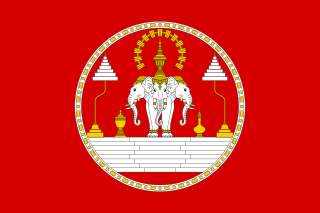
The Lao Royal Family was the ruling family of the Kingdom of Laos from 1904 to 1975 and the group of close relatives of the monarch of the Kingdom of Laos. King Sisavang Vong was the founder of the modern family, consisting of a number of persons in the Lao Royal Dynasty of the Khun Lo, who are related to the King of Laos, who are entitled to royal titles, and some of whom performed various official engagements on behalf of the Royal Family and ceremonial duties of State when the Kingdom existed. The Lao Royals are now based in France, where they work to achieve a change of government in Laos.

The Lao Issara was an anti-French, nationalist movement formed on 12 October 1945 by Prince Phetsarath. This short-lived movement emerged after the Japanese defeat in World War II and became the government of Laos before the return of the French. It aimed to prevent the French from restoring their control over Laos. The group disbanded in 1949.

The Order of Civic Merit of the Kingdom of Laos was established on November 20, 1950 under Royal Ordinance No. 186 by H.M. Sisavang Phoulivong, The King of Laos. It is an Order of Civic Merit for civil officials and military officers. It was awarded for meritorious and courageous service to the State in three classes. Until 1975 the approval authority was the Prime Minister of the Royal Lao Government. The current approval authority is H.E. Professor Maha Khamphoui Sisavatdy, Prime Minister of the Royal Lao Government in Exile as an elected successor to the Office of the Prime Minister of the Royal Lao Government.
